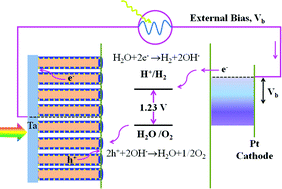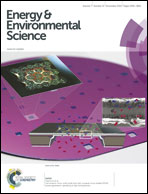High-performance p-Cu2O/n-TaON heterojunction nanorod photoanodes passivated with an ultrathin carbon sheath for photoelectrochemical water splitting†
Abstract
Considerable efforts have been made to design and discover photoactive nanostructured (oxy)nitride materials that can be used as photoanodes for photoelectrochemical (PEC) water splitting. However, the high recombination rate of photoexcited electron–hole pairs and the poor photostability have greatly limited their practical applications. Herein, a p-type Cu2O/n-type TaON heterojunction nanorod array passivated with an ultrathin carbon sheath (carbon–Cu2O/TaON) as a surface protection layer was produced via a solution-based process. Due to the shape anisotropy and p–n heterojunction structure, the photocurrent density of carbon–Cu2O/TaON heterojunction nanorod arrays as the integrated photoanode, with a maximum IPCE of 59% at a wavelength of 400 nm, reached 3.06 mA cm−2 under AM 1.5G simulated sunlight at 1.0 V vs. RHE and remained at about 87.3% of the initial activity after 60 min irradiation. Not only is the onset potential negatively shifted but the photocurrent density and photostability are also significantly improved for this photoanode compared to those of TaON and Cu2O/TaON. These improvements are due to a high built-in potential in the p–n heterojunction device that is protected from the electrolyte by being encapsulated in an ultrathin graphitic carbon sheath. Our design introduces material components to provide a dedicated charge-transport pathway, alleviating the reliance on the materials' intrinsic properties, and therefore has the potential to greatly broaden where and how various existing materials can be used in energy-related applications.


 Please wait while we load your content...
Please wait while we load your content...